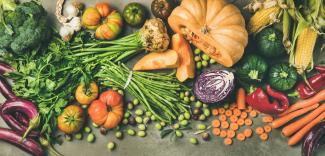Benefits of Eating Seasonally

With every change of season comes a new array of nourishing, whole foods. But we do have one small problem. No matter the time of the year, you can walk into a supermarket and see mangos on the left and tomatoes on the right. Due to constantly having this broad variety of produce at our fingertips, we are missing out on the real benefits of eating with the seasons! A seasonal plate is not just a trendy food movement. Let’s take a closer look.
In the past, people knew which foods were in season, but we’ve lost touch with that basic idea with ease of availability. Eating with the season is important and has several nutritional and health benefits. The idea of seasonal eating is to eat certain foods during certain months for optimal health, nutrition and disease prevention. Seasonal foods not only offer more health benefits, but they are also tastier. Foods grown and produced in season are better for the environment and often are less expensive. Part of eating seasonally involves eating locally-sourced foods. Where to find seasonal ingredients varies, but usually small grocers, farm stands or farmers markets have more local options to choose from.
From a nutritional standpoint, when foods are grown and eaten during their appropriate seasons, they are more nutritionally dense. For example, broccoli produced during fall, its peak season, has a higher vitamin C content than broccoli grown during other seasons. Northeast produce differs from the West Coast, so be sure to consider that each area has its own seasonal produce. If you plan to shop local, check for specific fruits and vegetables that are in season for your state or location.
Seasonal eating enhances variation in your diet! Seeking out and trying new fruits and vegetables that are in season is a great way to vary what you are eating. Make it a point to try different types of produce. This can open up a whole new world of foods and nutrients! Key to a health-promoting diet is eating a wide range of fresh fruits and vegetables that are rich in different nutrients. Eating seasonally expands this approach and makes mealtime more interesting and engaging.
Foods consumed in their unnatural season are not as nutritious or flavorful as seasonal produce. The cost of seasonal fruits and vegetables is usually less too since you’re not paying extra for transport or shipping. So, you are not only saving money but you are able to absorb extra nutrients from the food you eat at its peak.
Finally, consider our environment. It’s far more beneficial for the environment to buy produce that is both seasonal and local. Buying local means buying foods that have undergone less travel, processing, and packaging. Most of us don’t know that on average, fruits and vegetables travel 1,300–2,000 miles to get from farms to stores in our area. This has a negative impact on our environment: the ships, planes, and trucks used to transport food use a lot of fuel, which pollutes our water, air, and land.
With all of these wonderful benefits from eating seasonally, it’s hard not to give it a chance. However, don’t think eating seasonally has to be a 100 percent commitment. If you like some fruits and vegetables that are available year-round, go ahead and have them. Start small in adding seasonal items to your diet, and continue to add more as you can. Know that with each seasonal item you choose, you are improving your nutrient intake, saving money, and making a better choice for the environment.
